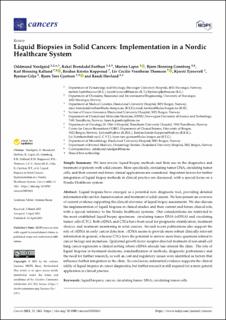| dc.contributor.author | Nordgård, Oddmund | |
| dc.contributor.author | Forthun, Rakel Brendsdal | |
| dc.contributor.author | Lapin, Morten | |
| dc.contributor.author | Grønberg, Bjørn Henning | |
| dc.contributor.author | Kalland, Karl Henning | |
| dc.contributor.author | Kopperud, Reidun Kristin | |
| dc.contributor.author | Thomsen, Liv Cecilie Vestrheim | |
| dc.contributor.author | Tjensvoll, Kjersti | |
| dc.contributor.author | Gilje, Bjørnar | |
| dc.contributor.author | Gjertsen, Bjørn Tore | |
| dc.contributor.author | Hovland, Randi | |
| dc.date.accessioned | 2021-11-11T09:06:09Z | |
| dc.date.available | 2021-11-11T09:06:09Z | |
| dc.date.created | 2021-05-31T10:00:21Z | |
| dc.date.issued | 2021-04 | |
| dc.identifier.citation | Nordgård, O., Forthun, R.B., Lapin, M. et al. (2021) Liquid Biopsies in Solid Cancers: Implementation in a Nordic Healthcare System. Cancers, 13 (8), 1861. | en_US |
| dc.identifier.issn | 2072-6694 | |
| dc.identifier.uri | https://hdl.handle.net/11250/2829025 | |
| dc.description.abstract | Liquid biopsies have emerged as a potential new diagnostic tool, providing detailed information relevant for characterization and treatment of solid cancers. We here present an overview of current evidence supporting the clinical relevance of liquid biopsy assessments. We also discuss the implementation of liquid biopsies in clinical studies and their current and future clinical role, with a special reference to the Nordic healthcare systems. Our considerations are restricted to the most established liquid biopsy specimens: circulating tumor DNA (ctDNA) and circulating tumor cells (CTC). Both ctDNA and CTCs have been used for prognostic stratification, treatment choices, and treatment monitoring in solid cancers. Several recent publications also support the role of ctDNA in early cancer detection. ctDNA seems to provide more robust clinically relevant information in general, whereas CTCs have the potential to answer more basic questions related to cancer biology and metastasis. Epidermal growth factor receptor-directed treatment of non-small-cell lung cancer represents a clinical setting where ctDNA already has entered the clinic. The role of liquid biopsies in treatment decisions, standardization of methods, diagnostic performance and the need for further research, as well as cost and regulatory issues were identified as factors that influence further integration in the clinic. In conclusion, substantial evidence supports the clinical utility of liquid biopsies in cancer diagnostics, but further research is still required for a more general application in clinical practice. | en_US |
| dc.language.iso | eng | en_US |
| dc.publisher | MDPI | en_US |
| dc.rights | Navngivelse 4.0 Internasjonal | * |
| dc.rights.uri | http://creativecommons.org/licenses/by/4.0/deed.no | * |
| dc.subject | onkologi | en_US |
| dc.subject | biopsi | en_US |
| dc.subject | sirkulerende kreftceller | en_US |
| dc.title | Liquid Biopsies in Solid Cancers: Implementation in a Nordic Healthcare System | en_US |
| dc.type | Peer reviewed | en_US |
| dc.type | Journal article | en_US |
| dc.description.version | publishedVersion | en_US |
| dc.rights.holder | © 2021 by the authors | en_US |
| dc.subject.nsi | VDP::Medisinske Fag: 700::Klinisk medisinske fag: 750::Onkologi: 762 | en_US |
| dc.source.pagenumber | 17 | en_US |
| dc.source.volume | 13 | en_US |
| dc.source.journal | Cancers | en_US |
| dc.source.issue | 8 | en_US |
| dc.identifier.doi | 10.3390/cancers13081861 | |
| dc.identifier.cristin | 1912746 | |
| dc.source.articlenumber | 1861 | en_US |
| cristin.ispublished | true | |
| cristin.fulltext | original | |
| cristin.qualitycode | 1 | |

